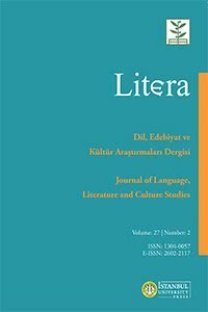Reflection of the Time Model Through German Derivational Structures
concept of TIME, cyclic time model, temporal nominators in the class of German nouns, compound word, propositional structure
___
Arutyunova, N.D. (1999). Language and Human World. Moscow: Languages of Russian Culture.Carl, H. (1995). German Plant and Animal Names. Heidelberg, Wiesbaden: Quelle&Meyer.
Der Sprach-Brockhaus (1984). German Picture Dictionary from A to Z. Wiesbaden: Brockhaus.
Duden (1996). Duden German Universal Dictionary. Mannheim: Dudenverlag.
Kant, I. (1966). Works in 6 Volumes / in V.F. Asmus, A.V. Guliga, T.I. Oizerman (eds.). Series Philosophical Heritage. Retrieved from https://platona.net/load/knigi_po_filosofii/istorija_nemeckaja_klassicheskaja/kant_ immanuil_sochinenija_v_6_tomakh/12-1-0-1481
Kravchenko, A.V. (2004). Language and Perception: Cognitive Aspects of Language Categorization (2nd ed.). Irkutsk: Irkutsk State University Publishing House.
Kubryakova, E.S. (2004). Language and Knowledge. Moscow: Languages of Slavic Culture.
Newton, I. (1687). Mathematical Principles of Nature Sciences. Retrieved from URL: https://de.wikipedia.org/wiki/ Zeit
Pankrats, Yu.G. (1992). Propositional Form of Knowledge Representation. Language and Structures of Knowledge Representation. Moscow: INION Publishing House.
Teliya, V.N. (1988). Metaphorization and its Role in the Creation of a Language Picture of the World. The Role of Human Factor in Language: Language and World View. Moscow: Science.
Voronina, L., Skokova, T., Melnikova, Y., Yarygina, O., & Miroshnichenko, G. (2018). The Role of Language Representation of the Time Model in the Process of Meaning Creation. Journal of History Culture and Art Research, 7(2), 94-100. doi:http://dx.doi.org/10.7596/taksad.v7i2.1586
Wahrig, G. (2001). German dictionary. Gütersloh, München: Bertelsmann Lexikon Verlag.
- Yayın Aralığı: Yılda 2 Sayı
- Yayıncı: İstanbul Üniversitesi
Aidiyetsiz Kahramanlar: Milan Kundera’nın Bilmemek Romanında Çoksesli Anlatı
Fatma AKBULUT, Bülent ÇAĞLAKPINAR
Lehçede Söz Türetme Yöntemlerine Genel Bir Bakış
Reflection of the Time Model Through German Derivational Structures
Rethinking the Man in Black: The Unconscious as a Mechanism in El cuarto de atrás
